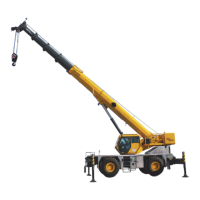GROVE Published 10-21-2010, Control# 198-04 4-1
5540F/YB5515 SERVICE MANUAL HYDRAULIC SYSTEM
SECTION 4
HYDRAULIC SYSTEM
TECHNICAL DATA
Hydraulic Pressures:
Hoist and Boom (Lift) Circuits.....................................................................3500 ±50 psi (24,132 ±345 kPa)
Telescope and Outrigger Circuits ...............................................................3500 ±50 psi (24,132 ±345 kPa)
Swing Circuit ..............................................................................................2000 ±50 psi (13,790 ±345 kPa)
Steering Circuit...........................................................................................2500 ±50 psi (17,237 ±345 kPa)
Rated Pump Output at 2600 rpm:
Section 1 ....................................................................................................24 gpm (91 lpm)
Section 2 ....................................................................................................22.8 gpm (86.3 lpm)
Section 3 ....................................................................................................13.2 gpm (49.9 lpm)
Section 4 ....................................................................................................13.2 gpm (49.9 lpm)
GENERAL DESCRIPTION
General
A hydraulic system uses liquid to make a transfer of force.
Any force on a confined liquid is applied to any point in the
system that the liquid reaches. Oil is used as the hydraulic
liquid for this system because the liquid must be a lubricant
for the components of the system.
There are several main components in a hydraulic system.
Each component has a specific function in the system.
The pump moves the oil through the system. It is important
to remember that the pump causes the flow, not the pressure
in the system. Pressure is caused by resistance to the flow.
This resistance can be external (for example, a load on a
cylinder or motor), or internal (the resistance of the
components of the system). Pressure increases as the
resistance to the flow increases. The pump will continue to
push more oil into the system until the resistance is
overcome or the relief valve opens (fixed displacement
pumps) or the pump compensator setting is reached
(variable displacement pumps).
Valves are used to control the flow, pressure, direction, and
volume of the oil in the system. There are many different
types of valves. An explanation of the different valves used
on this machine is given in the description of each circuit.
Filters remove dirt and particles of foreign materials from the
oil in the system. The oil in the system must be kept clean to
inhibit damage to the pumps, cylinders, valves, and other
components of the system.
Motors and Cylinders are the actuators or working tools of
the system. In the motors and cylinders, hydraulic energy is
changed into mechanical force (rotary or straight line
movement).
The Hydraulic Oil Tank has three important functions:
storage, cooling, and supply of oil to the pumps. Because
piston rods take space in the cylinders, the level of the oil in
the tank will be higher when all the cylinders are retracted.
To understand how a hydraulic system works, it is important
to understand the following words:
Flow - The flow through the system is caused by the pump.
The amount of fluid which is sent to a circuit or actuator
generally controls the speed of that function. The flow is
measured in gallons per minute (gpm) or liters per minute
(lpm).
Pressure - is caused by any resistance to the flow of the oil.
Pressure is normally measured in pounds per square inch
(psi) or kilopascals (kPa). There are four general types of
pressure.
• High Pressure, which is normally the result of an
external load on the system.
• Low Pressure, normally the result of the internal
resistance of the components in the system.
• Static Pressure, where the oil is closed in a circuit
between two components. There is no movement of the
oil, but there is pressure on the oil, normally because
there is an external load on the circuit.
• Series Pressure, which is found where oil is confined
between two components in a series arrangement, for
example when the rod port of one cylinder is connected
to the base port of another cylinder. Movement of either
cylinder will cause movement in the other cylinder.
Hydraulic System
There are four hydraulic systems on this machine.
Information on the hydraulic system for the transmission,
brakes, and steering is found in Sections 5, 7and 8
respectively. Only the main hydraulic system is included in
Reference Only
